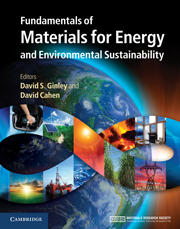Book contents
- Frontmatter
- Contents
- Contributors
- Preface
- Acknowledgments
- Part 1 Energy and the environment: the global landscape
- Part 2 Nonrenewable energy sources
- Part 3 Renewable energy sources
- Part 4 Transportation
- Part 5 Energy efficiency
- 35 Lighting
- 36 Energy efficient buildings
- 37 Insulation science
- 38 Industrial energy efficiency: a case study
- 39 Green processing: catalysis
- 40 Materials availability and recycling
- 41 Life-cycle assessment
- Part 6 Energy storage, high-penetration renewables, and grid stabilization
- Summary
- Appendix A Thermodynamics
- Appendix B Electrochemistry
- Appendix C Units
- Index
- References
40 - Materials availability and recycling
from Part 5 - Energy efficiency
Published online by Cambridge University Press: 05 June 2012
- Frontmatter
- Contents
- Contributors
- Preface
- Acknowledgments
- Part 1 Energy and the environment: the global landscape
- Part 2 Nonrenewable energy sources
- Part 3 Renewable energy sources
- Part 4 Transportation
- Part 5 Energy efficiency
- 35 Lighting
- 36 Energy efficient buildings
- 37 Insulation science
- 38 Industrial energy efficiency: a case study
- 39 Green processing: catalysis
- 40 Materials availability and recycling
- 41 Life-cycle assessment
- Part 6 Energy storage, high-penetration renewables, and grid stabilization
- Summary
- Appendix A Thermodynamics
- Appendix B Electrochemistry
- Appendix C Units
- Index
- References
Summary
Focus
The financial future of firms that depend on materials can be permanently compromised if the availability of those materials is constrained. This chapter examines how limited materials availability can affect a firm; how a firm can know whether it is using materials that are at risk of becoming of limited availability; and what can be done to mitigate that risk. One mitigation strategy is to foster an effective recycling system. The chapter concludes by exploring the benefits of expanded recycling and some of the remaining challenges to making that happen.
Synopsis
Resource scarcity is a topic that has challenged scientists, engineers, and economists for centuries. Current interest in this topic stems from the central role of natural resources in our economy, the inherently finite supply of those resources, and the unprecedented rate of resource consumption.
- Type
- Chapter
- Information
- Publisher: Cambridge University PressPrint publication year: 2011

